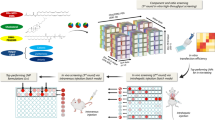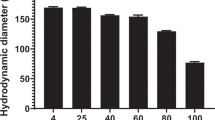Abstract
A novel lipidic vector composed of DOTAP/Chol liposomes, asialofetuin (AF), protamine sulfate and DNA has been developed. The resulting protamine-AF-lipoplexes improved significantly the levels of gene expression in cultured cells and in the liver upon i.v. administration. Lipoplexes containing the optimal amount of AF (1 μg/μg DNA) showed a 16-fold higher transfection activity in HepG2 cells than non-targeted (plain) complexes. The uptake by cells having asialoglycoprotein receptors (ASGPr) on their plasma membrane was decreased by the addition of free AF, indicating that AF-lipoplexes were taken up specifically by cells via ASGPr-mediated endocytosis. Results from transfections performed in cells defective in ASGPr, ie HeLa cells, confirmed this mechanism. By addition of the condensing peptide, protamine sulfate, smaller complexes were obtained, which enhanced even more the uptake of AF-complexes in HepG2 cells and in the liver. The optimal amount of protamine was 0.4 μg/μg DNA, and gene expression was about 5-fold over that obtained with AF-lipoplexes in the absence of the peptide, and 75-fold higher than that with plain conventional lipoplexes. Protamine-AF-lipoplexes increased by a factor of 12 luciferase gene expression in the liver of mice administered systemically via the tail vein, compared to plain complexes. In summary, our findings extend the scope of previous studies where AF-lipoplexes were used to introduce DNA into hepatocytes. The combination of targeting and protamine condensation obviated the need for partial hepatectomy, commonly required to obtain efficient gene delivery in this organ. Since protamine sulfate has been proven to be non-toxic in humans, the novel liver-specific vector described here may be useful for the delivery of clinically important genes to this organ.
This is a preview of subscription content, access via your institution
Access options
Subscribe to this journal
Receive 12 print issues and online access
$259.00 per year
only $21.58 per issue
Buy this article
- Purchase on Springer Link
- Instant access to full article PDF
Prices may be subject to local taxes which are calculated during checkout








Similar content being viewed by others
References
Ashwell G, Morell AG . The role of surface carbohydrates in the hepatic recognition and transport of circulating glycoproteins. Adv Enzymol Relat Areas Mol Biol 1974; 41: 99–128.
Wu J et al. Increased liver uptake of liposomes and improved targeting efficacy by labeling with asialofetuin in rodents. Hepatology 1998; 27: 772–778.
Kitten O, Cosset FL, Ferry N . Highly efficient retrovirus-mediated gene transfer into rat hepatocytes in vivo. Hum Gene Ther 1997; 8: 1491–1494.
Schiedner G et al. Genomic DNA transfer with a high-capacity adenovirus vector results in improved in vivo gene expression and decreased toxicity. Nat Genet 1998; 18: 180–183.
Nakai H et al. Adeno-associated viral vector-mediated gene transfer of human blood coagulation factor IX into mouse liver. Blood 1998; 91: 4600–4607.
Alino SF, Bobadilla M, Crespo J, Lejarreta M . Human alpha 1-antitrypsin gene transfer to in vivo mouse hepatocytes. Hum Gene Ther 1996; 7: 531–536.
Wu J, Zern MA . Modification of liposomes for liver targeting. J Hepatol 1996; 24: 757–763.
Tomita N et al. In vivo gene transfer of insulin gene into neonatal rats by the HVJ-liposome method resulted in sustained transgene expression. Gene Ther 1996; 3: 477–482.
Cheng L, Ziegelhoffer PR, Yang NS . In vivo promoter activity and transgene expression in mammalian somatic tissues evaluated by using particle bombardment. Proc Natl Acad Sci USA 1993; 90: 4455–4459.
Yoshida Y et al. Introduction of DNA into rat liver with a hand-held gene gun: distribution of the expressed enzyme [32P]DNA and Ca2+ flux. Biochem Biophys Res Commun 1997; 234: 695–700.
Suzuki T et al. Direct gene transfer into rat liver cells by in vivo electroporation. FEBS Lett 1998; 425: 436–440.
Hara T, Tan Y, Huang L . In vivo gene delivery to the liver using reconstituted chylomicron remnants as a novel nonviral vector. Proc Natl Acad Sci USA 1997; 94: 14547–14552.
Wagner E et al. Coupling of adenovirus to transferrin-polylysine/DNA complexes greatly enhances receptor-mediated gene delivery and expression of transfected genes. Proc Natl Acad Sci USA 1992; 89: 6099–6103.
Liu F, Song Y, Liu D . Hydrodynamics-based transfection in animals by systemic administration of plasmid DNA. Gene Ther 1999; 6: 1258–1266.
Zhang G, Song YK, Liu D . Long-term expression of human alpha1-antitrypsin gene in mouse liver achieved by intravenous administration of plasmid DNA using a hydrodynamics-based procedure. Gene Ther 2000; 7: 1344–1349.
Malone RW et al. Dexamethasone enhancement of gene expression after direct hepatic DNA injection. J Biol Chem 1994; 269: 29903–29907.
Wu GY, Wu CH . Receptor-mediated in vitro gene transformation by a soluble DNA carrier system. J Biol Chem 1987; 262: 4429–4432.
Makdisi WJ, Wu CH, Wu GY . Methods of gene transfer into hepatocytes: progress toward gene therapy. Prog Liver Dis 1992; 10: 1–24.
Wilson JM et al. A novel mechanism for achieving transgene persistence in vivo after somatic gene transfer into hepatocytes. J Biol Chem 1992; 267: 11483–11489.
Wu GY et al. Receptor-mediated gene delivery in vivo Partial correction of genetic analbuminemia in Nagase rats. J Biol Chem 1991; 266: 14338–14342.
Wu GY, Wu CH . Evidence for targeted gene delivery to HepG2 hepatoma cells in vitro. Biochemistry 1988; 27: 887–892.
Wu CH, Wilson JM, Wu GY . Targeting genes: delivery and persistent expression of a foreign gene driven by mammalian regulatory elements in vivo. J Biol Chem 1989; 264: 16985–16987.
Shen WC, Ryser HJ . Conjugation of poly-L-lysine to albumin and horseradish peroxidase: a novel method of enhancing the cellular uptake of proteins. Proc Natl Acad Sci USA 1978; 75: 1872–1876.
Liu G et al. Biological properties of poly-L-lysine–DNA complexes generated by cooperative binding of the polycation. J Biol Chem 2001; 276: 34379–34387.
Martinez-Fong D et al. Nonenzymatic glycosylation of poly-L-lysine: a new tool for targeted gene delivery. Hepatology 1994; 20: 1602–1608.
Murahashi N et al. Hepatic accumulation of glutamic acid branched neogalactosyllipid modified liposomes. Biol Pharm Bull 1997; 20: 259–266.
Shimada K et al. Biodistribution of liposomes containing synthetic galactose-terminated diacylglyceryl-poly(ethyleneglycol)s. Biochim Biophys Acta 1997; 1326: 329–341.
Hara T et al. Receptor-mediated transfer of pSV2CAT DNA to a human hepatoblastoma cell line HepG2 using asialofetuin-labeled cationic liposomes. Gene 1995; 159: 167–174.
Hara T et al. Receptor-mediated transfer of pSV2CAT DNA to mouse liver cells using asialofetuin-labeled liposomes. Gene Ther 1995; 2: 784–788.
Hara T et al. Effects of fusogenic and DNA-binding amphiphilic compounds on the receptor-mediated gene transfer into hepatic cells by asialofetuin-labeled liposomes. Biochim Biophys Acta 1996; 1278: 51–58.
Zanta MA, Boussif O, Adib A, Behr JP . In vitro gene delivery to hepatocytes with galactosylated polyethylenimine. Bioconjug Chem 1997; 8: 839–844.
Perales JC et al. Gene transfer in vivo: sustained expression and regulation of genes introduced into the liver by receptor-targeted uptake. Proc Natl Acad Sci USA 1994; 91: 4086–4090.
Ferkol T et al. Regulation of the phosphoenolpyruvate carboxykinase/human factor IX gene introduced into the livers of adult rats by receptor-mediated gene transfer. FASEB J 1993; 7:1081–1091.
Sorgi FL, Bhattacharya S, Huang L . Protamine sulfate enhances lipid-mediated gene transfer. Gene Ther 1997; 4: 961–968.
Gao X, Huang L . Potentiation of cationic liposome-mediated gene delivery by polycations. Biochemistry 1996; 35: 1027–1036.
Li S, Huang L . In vivo gene transfer via intravenous administration of cationic lipid–protamine–DNA (LPD) complexes. Gene Ther 1997; 4: 891–900.
Schwartz B et al. Synthetic DNA-compacting peptides derived from human sequence enhance cationic lipid-mediated gene transfer in vitro and in vivo. Gene Ther 1999; 6: 282–292.
Barthel F, Remy JS, Loeffler JP, Behr JP . Gene transfer optimization with lipospermine-coated DNA. DNA Cell Biol 1993; 12: 553–560.
Takeuchi K et al. Effect of zeta potential of cationic liposomes containing cationic cholesterol derivatives on gene transfection. FEBS Lett 1996; 397: 207–209.
Templeton NS et al. Improved DNA: liposome complexes for increased systemic delivery and gene expression. Nat Biotechnol 1997; 15: 647–652.
Machy P, Leserman LD . Small liposomes are better than large liposomes for specific drug delivery in vitro. Biochim Biophys Acta 1983; 730: 313–320.
Simões S et al. Mechanisms of gene transfer mediated by lipoplexes associated with targeting ligands or pH-sensitive peptides. Gene Ther 1999; 6: 1798–1807.
Tros de Ilarduya C, Düzgüneş N . Efficient gene transfer by transferrin lipoplexes in the presence of serum. Biochim Biophys Acta 2000; 1463: 333–342.
Tros de Ilarduya C, Arangoa MA, Moreno-Aliaga MJ, Düzgüne° N . Enhanced gene delivery in vitro and in vivo by improved transferrin-lipoplexes. Biochim Biophys Acta 2002; 1561: 209–221.
Konopka K, Pretzer E, Felgner PL, Düzgüneş N . Human immunodeficiency virus type-1 (HIV-1) infection increases the sensitivity of macrophages and THP-1 cells to cytotoxicity by cationic liposomes. Biochim Biophys Acta 1996; 1312: 186–196.
Acknowledgements
This work was supported by a grant from the Government of Navarra (Department of Education), the Echebano Foundation and the University of Navarra.
Author information
Authors and Affiliations
Rights and permissions
About this article
Cite this article
Arangoa, M., Düzgüneş, N. & Tros de Ilarduya, C. Increased receptor-mediated gene delivery to the liver by protamine-enhanced-asialofetuin-lipoplexes. Gene Ther 10, 5–14 (2003). https://doi.org/10.1038/sj.gt.3301840
Received:
Accepted:
Published:
Issue Date:
DOI: https://doi.org/10.1038/sj.gt.3301840
Keywords
This article is cited by
-
Targeting strategies with lipid vectors for nucleic acid supplementation therapy in Fabry disease: a systematic review
Drug Delivery and Translational Research (2024)
-
LYTACs that engage the asialoglycoprotein receptor for targeted protein degradation
Nature Chemical Biology (2021)
-
Characterization of the human dynein light chain Rp3 and its use as a non-viral gene delivery vector
Applied Microbiology and Biotechnology (2014)
-
Evaluation of pullulan-functionalized doxorubicin nanoparticles for asialoglycoprotein receptor-mediated uptake in Hep G2 cell line
Cancer Nanotechnology (2011)
-
Characteristics comparison before and after lyophilization of transferrin modified procationic- liposome- protamine- DNA complexes (Tf- PLPD)
Archives of Pharmacal Research (2007)



